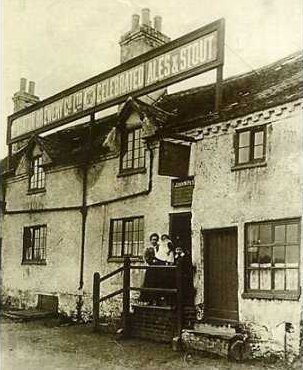It is a simple fact that drinking is something which the folk of Whitwick and Thringstone always seemed to have held dear. When the Three Tuns re-applied for licensing in 1930, the local constabulary objected on the grounds that with a population of 1,447, Thringstone had one licensed premises for every 161 people, compared to the 252 for the whole of the Ashby Division. Five pubs have managed to survive to the present day, while a social club was built in the village in the early 1970s. Other pubs that were once classed as being in Thringstone ceded to Coleorton when parochial boundaries were changed in 1936. For the time being, here I have included only the public houses which conform to a present-day understanding of Thringstone. This page will be the subject of continued research, construction and revision.
The Bulls Head
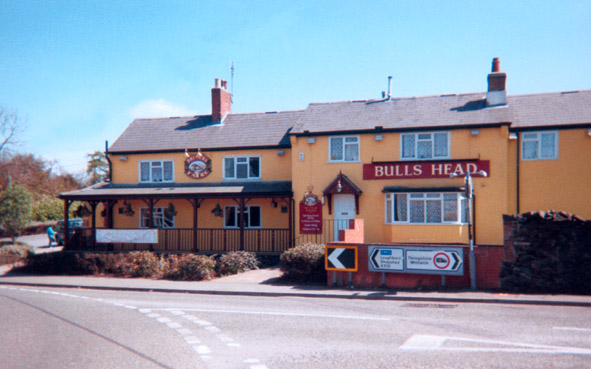 |
Above, The Bulls Head at Gracedieu, May 2001
(Photo by Steve Badcock)
The Bulls Head is sited at a spot known locally as 'Cross-lanes', not far away from the ruins of Gracedieu, and was probably once part of the De Lisle estate. The pub is shown on Smith's map of 1807. The building underwent major structural alterations about ten years ago when the premises was converted into a pub-restaurant by Malcolm Allured, a former drummer with the pop group, 'Showaddywaddy'.
Landlords of the Bulls Head have included: William Merriman (1846); Sarah Merriman (1854); William Gough (1862); George Harriman (1870); James Peters (1881); Isaac Newton (1887); Charles Gough (1887/1904); Esther Gough (1912); Edmund A Holmes (1925/1928); Alfred William Wilkinson (1937); Cyril Stanley (1937); Alfred Smith Pepper (1938-40); Joseph Herbert Mabe (1941); Alan Spurr (1977).
The Fox Inn
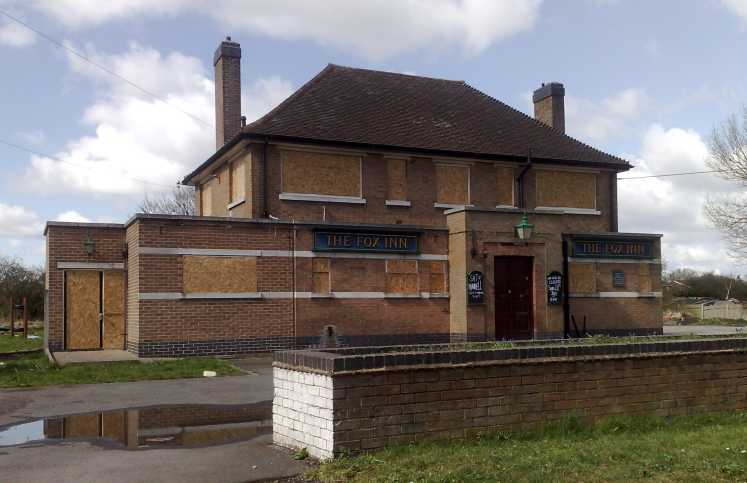
(Photo by Stephen Neale Badcock. 06.04.08)
Above: The Fox Inn at Thringstone (April 2008), one of several in the district to close around this time.
The Fox Inn is a large brick building which was erected in 1955 to replace an old pub of the same name. The original inn had stood nearer to the road, and there is an interesting photograph which shows the then landlord, Mr George Musson, and numerous locals, walking from the back of the old pub to the new one at the time of the opening ceremony.
A newspaper account of 1882 describes the original inn as having been "ancient", though unfortunately we have not yet found a photograph which shows it in any sort of detail.
The story goes that the old Fox suffered structural damage when
a German bomb was dropped nearby during World War Two, and that this played a
part in its eventual destruction. An interesting email was received from Beverley Croasdell of Worcester on 17.11.2005, whose great aunt, Mary Anne Musson, was landlady of the inn for many years. Beverley writes, 'The story I was told was the bomb landed at the back of the pub in a field and all the windows were blown out'.
However, the 'Thringstone Blitz' occurred in October 1940 and it was not until 1955 that the old Fox was demolished so it is likely that the pub's destruction had little connection with the Luftwaffe.
In August 2000, the Fox gained an interesting feature when new landlord, Jeremy Clapham, unveiled a Dalek in the pub foyer. The Dalek, housed in a metal cage, originally appeared in the TV series, 'Dr Who', back in the early 1960s.
Landlords of the Fox Inn included: James Hawksworh (1841);
Nevill Branston (1846/1854); Robert Gregory (1855); Thomas Potter (1870); John
Posnett (1877); Joseph Brooks (1880); Elizabeth Potter (1881); John
Clarke(1884); Thomas Richardson (1886); William Saywell (1886); Silas Hill
(1888); John Emmerson (1888/1900); John Goodall (1896); John Thorley (1897);
Robert Maloney (1903)*; Herbert Stacey (1904); Ernest Corbett (1905); Samuel
Jarvis (1916); James Frederick Musson (1925); Mary Anne Musson (1928/1940);
George Thomas Musson (1941); Tony and Carol Spence(Until 1994); Tracey Thompson
; Franklyn and Ashley Northage (1998 - 2000); Sharon Y and Jeremy Clapham (2000
- 2002); Debbie Churchman (2002).
* Known to have been manager for John Emmerson, who owned 'Fox Row'
The George and Dragon
 |
Above: The George and Dragon pictured during Fredrick Brown's incumbency, circa 1912
Photograph supplied by Ron Goacher
Thoroughly refurbished and extended in 1999 to form a pub-restaurant, The George and Dragon is a very old building pleasantly located on the village greenbelt. An Elizabethan ship timber is believed to support part of the roof.
One former landlord, Joseph Wilson, lost his life in the Whitwick Colliery Disaster of 1898. His body was never recovered.
In 2007, the pub was taken over by Pete and Anne Gough and Steve and Maragaret Fern of Thringstone.
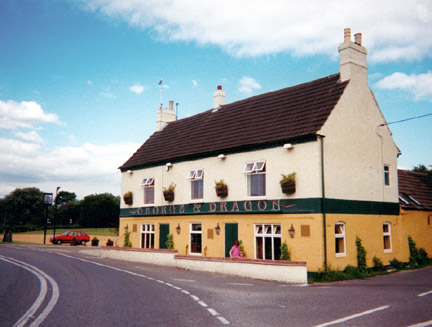 |
Ninety years on, little has changed structurally to the pub's frontage. The above photograph was taken in July 2000.
(Photo by Steve Badcock)
Landlords of the George and Dragon have included: Thomas Toone (1846/1861); William King (1862/1870); John Rennocks (1877); Thomas Chesterton (1887); Joseph Wilson (1891); William Lacy (1895); Thomas Abell (1900); Harry Loakes (1904); Fred Brown (1912); Percy Rossell (1925/1928); George Thomas Slim (1941); Jim and Sue Martin (1981-92); Sheridan Lee (1992-93); Yvonne P Dickinson (1993 - 99)
The Queens Head
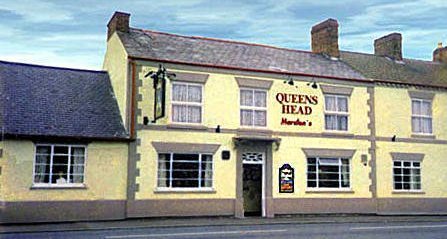 |
Photograph supplied by John and Debbie Roberts
This traditional Marstons pub formed the end of a row on the east side of the village Green. During the early 1980s the premises was extended by incorporating Jack Hall's shop next door, the evidence of which can be easily detected in the above photograph. It is also interesting to note that the drop to the cellar used to be under the window of the house next door to this. The cellar has long since been sealed off.
No properties appear on this site on Smith's map of 1807, though the pub is seen to be in the occupation of William Hallam some forty years later.
The Queens Head has enjoyed a good deal of family loyalty over the years, and the house was once synonymous with the Hallam family.
Samuel Wilson Hallam was of the village elite. The Coalville Times of May 1st 1903 reported, 'Mr.S.W.Hallam, of Thringstone, has recently purchased a motor car. It is of a handsome design, six horse power, and "made for two,"though it can be arranged to carry four.' In his will, Mr Hallam bequeathed £2,000 for the erection of a tower and bells at Holy Cross Roman Catholic Church, Whitwick, after the death of his wife. Mrs Hallam died only a fortnight after her husband and so the tower was built rather earlier than expected (probably completed by 1910). Samuel was succeeded as landlord by his brother, George, who died in 1924, after which time his widow kept the house until 1927. Throwing in an intriguing piece of trivia, it is remembered that George Hallam was known in the village as "Ang-barra" (Hang-barrow), though quite why this was is likely to remain one of life's mysteries !
It was probably Samuel Hallam that built the 'Club room', a long wooden structure to the rear of the premises which was heated by a free standing stove. This was used by the Thringstone Homing Society, Mr Hallam being a keen pigeon fancier. For many years this was also the meeting place for the Royal Antediluvian Order of the Buffaloes (Gracedieu Lodge), and it is remembered that a horned bison's head was mounted above the door. The club room was dismantled more than twenty-five years ago, when the pub's cellar was sealed off and the kegs were rehoused in a new room built on to the back of the pub at ground level.
Albert and Frank Waterfield (father and son) kept the house respectively for a combined period of more than twenty years until 1967, when Frank was succeeded by his brother-in-law, George Domoney. George's daughter, Lynne, later kept the pub with her husband Paul for six years, until 1993.
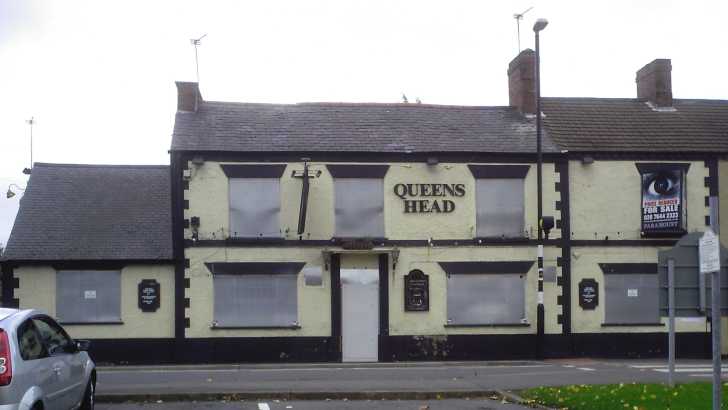
The Queen's Head, October 16 2008
(Photo by Mrs Pauline Badcock - thanks)
The Queens Head finally closed its doors in August 2008 and faces an uncertain future
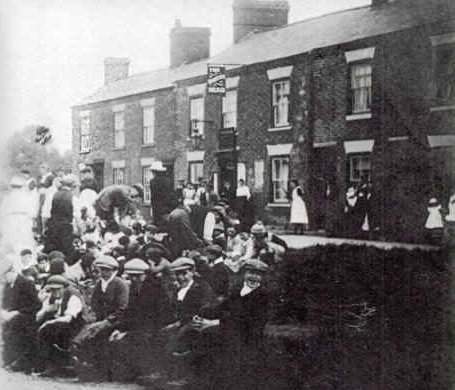 |
Above: An Edwardian view of the Queens Head from The Green. The event is a Foresters Sick Club picnic after a parade to Gracedieu Manor. The two houses to the left of the pub were demolished many years ago and this site is now taken up by a small car park and a ground floor extension to the bar.
Photograph supplied by Ron Goacher
Landlords of the Queens Head have included: William Hallam (1846); Robert Gregory (1854); Richard Hopper (1855); James Hopper (1861/1871); Richard Hallam (1877/1881); Samuel Wilson Hallam (1888-1908); George Henry Hallam (1908-1924); Alice Rebecca Hallam (1924-1927); George William Marklow (1928); John Hall (1941); Albert Edward Waterfield (1944-1953); Frank Edward Waterfield (1953-1967); George and Peggy Domoney; Ronald Perkins; Graham and Shirley Cutler (1985-1987); Paul and Lynne Kendrick (1987-1993); John Price (1993-1994); Denise Wilding and Michael Bates (1994-1996); John and Debbie Roberts (1996-2001); Patricia Kerr (2001-2003); Gill Prior (2003); Graham Cutler (2004-2005)
Rangers Supporters Club

The Rose and Crown
 |
Above: The Rose and Crown
The Old Rose and Crown (as it was once known) is a three-storeyed property forming part of a Georgian row on the west side of the village green. The adjoining property, 'Forest View House' (Number 25, The Green) is a grade two listed building and it is noticeable that some of the windows have been bricked up, probably as a result of eighteenth century window tax. The pub used to own the Green, and the old barn which stood here until 1929. The barn was once used to accommodate the horses of outriders who stayed at the Inn whilst on business in the district. The Green was sold to Thringstone Parish Council by Bass brewery in 1933, subsequently transferring to the Coalville Urban District when Thringstone Parish was dissolved in 1936. Interestingly, Bass sold the land for £1, so that it might be laid out and preserved as a Green. Sadly, today it is mostly car park !
There is a persistent rumour that the house adjoining the Rose and Crown was once a barracks. (There was also once a 'Barrack Yard' on Main Street, near the present-day turn into Glebe Road*). I am told that when the Rose and Crown was extended to incorporate modern toilet facilities (during Nan and Stans' tenure), a well of extraordinary width and depth was uncovered and subsequently capped. At the time of the discovery, it was even suggested to a member of the local constabulary accustomed to drinking there that he might use his influence to bring in police 'divers' to investigate the murky depths! (Bob Stinson). More research is planned in order to shed some light on the origins of the Rose and Crown row.
Landlords of the Rose and Crown have included: Thomas Kidger Ayre (1846/1854); George James Gough (1861/1881; died 1893); Joseph Leedham Gilbert (1886); Thomas Geary (1887); Hannah Hollingsworth (1891); George Painter (1895); Charles Thomas Wilkins (1900); Mr Jordan (1900); Frederick Thomas Wilkins (1904); Edgar Bennett (1912); James Smith (1916/1928); Alfred Sykes (1941); Mr Chapman; Mr Blaze; Richard and Nora Love (c.1959-1961); Danny Hatton; Stan and Nan Mellor; Keith and Sue Walker; Edward and Rose Anderson; Richard and Elaine Meason; Sheridan and Christine Lee (1988-1994); David and Dawn Ford (1995-1997); Helen and Glenn Robinson (1997-1999); Lillian and Paul Taylor (1999-2000:Managers); Margaret Bell (2000-2005)
The Star
|
The Star is now a private house, number 34 Main Street, located opposite the old school-house and easily distinguished by the steps and white palings which lead up to the front door. A barn-like outbuilding of old brick stands close by, at the bottom of the John Street footpath. The Star, like the Three Tuns, never had a full license, being classified as a "beer-on". For many years, the house was kept by Mr John William Peters, whose family was involved with the manufacture of ornamental spar ware at Bauble Yard, Thringstone. The establishment finally closed in 1928. The photograph on the left shows members of the Peters family outside the pub in about 1915. (Photo supplied by Ron Goacher). |
Landlords of the Star included:
Ann Hall (1882); James Walker Henson (1882-1883); George Henson (1883);
John Ward (1884/1891); James Bakewell (1897); W.B.Tolley (1905); John William
Peters (1905-1928)
The Three Tuns
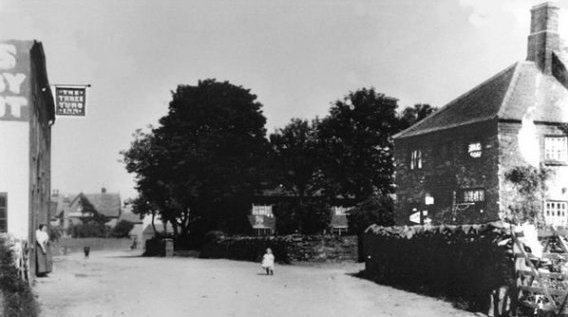 |
Above: The Three Tuns Inn. On the right hand side, directly opposite, can be seen "The Gables", which was then Towles' shop. The Gables is one of the oldest houses left in the village, probably dating from the mid-seventeenth century. An extension to the west end bears the date, 'AD 1682', carved in a stone recess.
Photograph supplied by Ron Goacher
The Three Tuns finally closed its doors in July 1931 and is now a private house, number 109 Main Street.
Landlords of the Three Tuns included:
James Wilson (1881); Mary Ann Wilson (1900/1916); Alice Shelton (1925/1931)
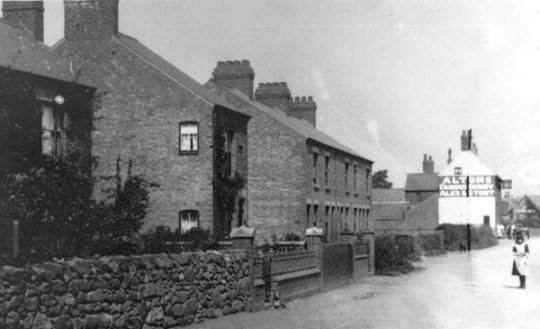 |
Above: Another view of Main Street with The Three Tuns in the background. Note the brewery's slogan painted across the side of the premises
Photograph supplied by Ron Goacher
Acknowledgements : Mr R Goacher; The Bass Museum, Burton Upon Trent.
A feature on the pubs of Whitwick is currently under construction.
(SNB)
One theory is that the name, "Barrack Yard" was a commemoration of the Crimean War. However, in his 'Reminiscences of Coalville', Samuel Fisher (1821-1901) recalls that there was once a group of houses standing near the Snibstone New Inn at Coalville which were also commonly known as "Barrack Row". Fisher attributes this to the fact that the houses were laid out in such a way that they resembled a barracks - "they were arranged as double houses with open entrances from front to back, doors opening on each side of the passages to give ingress to the occupiers".
Page design by G.Atkinson
